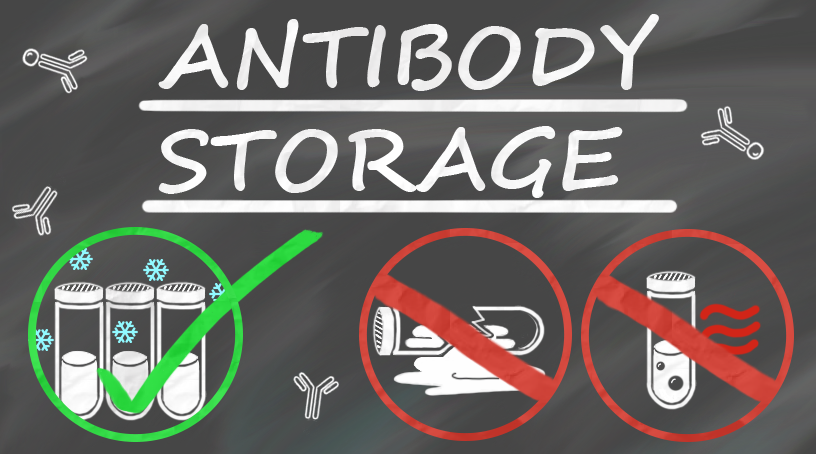Storage of Antibodies
How to store antibodies

The shelf life of an antibody is dependent upon the nature of the antibody and the conditions at which it is stored, with optimal storage conditions unique to each antibody. Guidelines are in place for the general storage of antibodies with a focus upon factors such as temperature, pH and the addition of substances such as glycerol and sucrose.
Temperature
Freezing antibodies at -20 °C to -80 °C in aliquots is often optimal for storage as this minimizes damage to the antibody. However, repeated freeze thaw cycles are very detrimental to the antibody as this process can cause denaturation and lead to the formation of aggregates. For this reason the use of a frost free freezer is not recommended due to the repeated freeze thaw cycles that the freezer undergoes to prevent frost build up. Likewise, aliquots should be placed in an area of the freezer that is exposed to few temperature fluctuations.
Oxidation and proteolytic degradation are chemical modifications recognized to be more pronounced in antibodies stored at higher temperatures. Short term storage of an antibody at 4 °C is not associated with a significant loss to the activity of the antibody. Storage at room temperature for the same amount of time however can induce antibody degradation and inactivity caused by microbial growth.
Lyophilisation and pH
Lyophilisation is often the preferred method for the long term storage of monoclonal antibodies that can be relatively unstable in liquid form. The advantage to this process is that it can preserve the antibody for 3 - 5 years without losing activity of the protein. It is also able to dry the antibodies at a lower temperature, decreasing the risk of damage to the protein structure. When the antibodies are required for use they can be reconstituted through the addition of deionised or distilled water. Once reconstituted the antibodies can last for 1 - 2 weeks at 2 °C - 8 °C or for up to a year when stored at -20 °C.
Lyophilising a protein causes the protein to become more sensitive to pH changes. A pH of 5 is recognized as the most stable whilst low pH's induce greater levels of protein aggregation through secondary and tertiary structural alterations. The addition of buffer salts can help to control the pH and reduce the risk of protein degradation. Residual water content has been found to help maintain antibody integrity with low water content not always relating to optimal stability.
Additives
The addition of agents such as glycerol and sucrose help to stabilize the protein during lyophilisation and storage, thereby preserving the native structure of the protein in its solid state. A specific molar ratio of sugar to protein is necessary as too much or too little could have the opposite or no effect. Overall, the level of stabilizers required is dependent upon the formulation of the antibody solution.
The use of glycerol is also recognized to help preserve the antibody by preventing the formation of hydrogen bonds between water molecules, this in turn stops the formation of ice crystals which can alter the antibodies structure rendering it ineffective. Glycerol addition lowers the freezing point of the antibody solution, with the freezing point dependent on the concentration of glycerol. Antibody solutions containing glycerol should not be stored at -80 °C as this is below the freezing point. It is important to note that purified glycerol must be used for this application as glycerol can be contaminated with microbes.
To prevent microbial contamination another agent that may be added to the antibody solution is sodium azide, this is often the preservative that is added to the final antibody preparation. Sodium azide must be removed if the antibody is required to undergo conjugation that involves an amine group. Removal of the sodium azide can be carried out through dialysis or gel filtration.
The addition of protease inhibitors can be beneficial when storing serum samples or ascites fluid as these often contain proteases which can break down the proteins through proteolytic cleavage.
Further considerations
Once an antibody has been thawed it must not be refrozen, any remainder should be stored in the fridge at 4 °C.
Individual aliquots should contain no less than 10 μl as the smaller the aliquot the more stock concentration will be affected by evaporation and absorption of the antibody onto the storage vial. For this reason, diluting samples in advance should also be avoided as proteins in general are less susceptible to degradation when stored at higher concentrations. Keeping the antibody concentration as high as possible during storage is advisable.
Exposure to light must also be considered when preserving an antibody, as UV light can alter the amino acid residues in proteins. Furthermore detergents such as Tween that may be present in antibody solutions can increase the sensitivity of proteins to such light. Another important factor to note is that any antibodies conjugated to agents such as fluorochromes, enzymes or biotin should always be stored in dark vials and kept away from sunlight as any exposure to unwanted light could compromise the activity of the conjugate.
